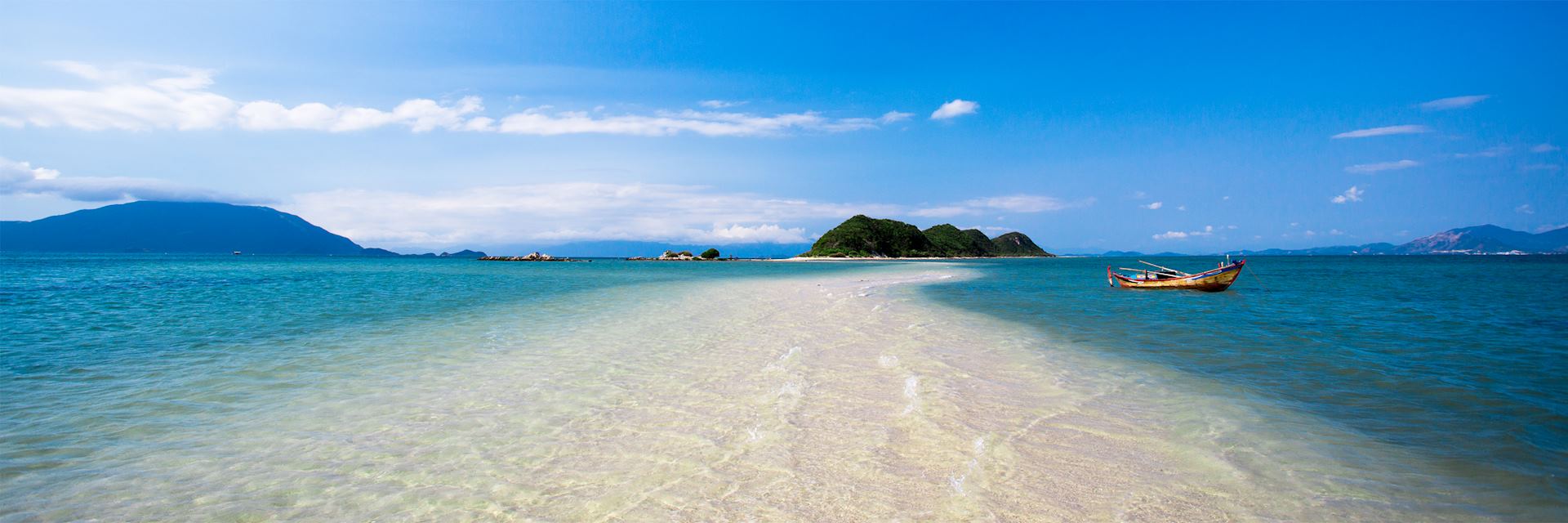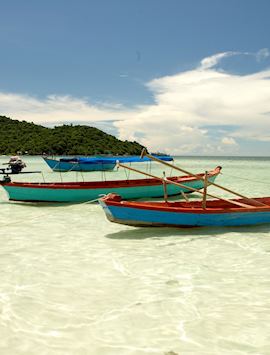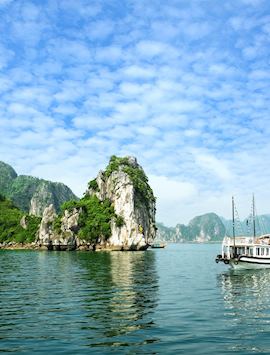By Vietnam specialist Mark
Vietnam’s beaches are surprisingly overlooked. The coastline sweeps in an S-shape from China in the north to Cambodia in the south. It passes through three different microclimates along the way, which means dry, sunny weather is always to be had on either the central or south coast, whatever time of year you travel. It also means that whatever tour of Vietnam you choose, you can incorporate in beach time easily enough.
For this guide, I’ve focused on the beaches of Vietnam’s central and south coasts (the north has untouched beaches but a limited infrastructure). There’s quite the range, from the secluded coves of Con Dao set in a protected marine park to the more developed Phu Quoc Island. Nha Trang is an established option with a wide range of hotels, while Qui Nhon is my tip for an up-and-coming beach destination in Vietnam.
Beaches and beach resorts in Central Vietnam
Best time to visit: between February and September
Central Vietnam’s beach-trimmed coast also plays host to two UNESCO World Heritage Sites, (Hue and Hoi An), which allows for some cultural exploration on top of your beach time.
Some bigger hotels are starting to appear, but the white-sand beaches are so long that they retain a quiet air. The waters are clear and turquoise, lending themselves to snorkelling and scuba diving, as well as fishing.
Away from the sea, Bach Ma National Park is a two-hour drive from Hoi An — the place the locals come to relax in the barely touched jungle, swimming in natural pools shaped by waterfalls.
Between Hue and Hoi An, there’s a selection of hotels along the coast. Quiet Lang Co Bay is my favourite beach in Vietnam — a crescent-moon of pearly white sand instead of the usual long sweep — and it’s mercifully undeveloped. The only hotels here are the five-star Banyan Tree, at the top end of the luxury scale, and the Angsana, a great family option.
The beach nearest to Hoi An is the setting for the Four Seasons Nam Hai, one of Vietnam’s best beach resorts for its exceptional service levels, large rooms and contemporary Vietnamese feel.

Qui Nhon
Best time to visit: between January and June
The beaches around the coastal city of Qui Nhon are by no means empty. But, so far, they remain mostly on the radar of Vietnamese holidaymakers and elderly couples heading here to retire.
Because of Qui Nhon’s position between Hoi An and Nha Trang, you’d need to fly in (and out) to build it into your trip, but it’s worth the jaunt.
You’ll find a long promenade to stroll along, and a vista of bright yellow and blue fishing boats on the water. At night, the sea lights up with the twinkle of shrimp-fishing boats.
Nearby, you can visit a pair of thousand-year-old Cham towers or head to a long, golden beach. For me, the area’s appeal is in its atmosphere — as you walk along the coast, you’ll pass a few relaxed beach bars, seafood restaurants and contemporary cafés.
Built side by side to the south of the city, the Avani Quy Nhon Resort and Spa and the Anantara Quy Nhon Villas occupy a quiet stretch of beach surrounded by low-lying jungle-covered hills. The contemporary Avani has good-value rooms and suites, while the more exclusive Anantara is a collection of villas, many with their own pool.

Beach holidays around Nha Trang
Best time to visit: between January and September
One of Vietnam’s first true beach resorts, Nha Trang is now a developed city with its own airport. The busy city gets a bit of bad press, but venture out of town and some of the area’s popularity might start to rub off. It’s graced with quiet bays, a mountainous backdrop, and calm blue waters. There’s something about the early-morning light here, too, which can magic up some of the best sunrises I’ve seen in Asia.
No, I don’t suggest spending much time in the city of Nha Trang — although, if you do stop, you can buy a great banh mi (baguette usually stuffed with pork and salad) from one of the open-sided cafés.
The real appeal of basing yourself here are the many hotels tucked away in their own secluded bays along the coastline. Some are so out-of-the way, you could trick yourself into thinking you were on a private island.

From Nha Trang, it’s 40 minutes by car then an exhilarating 20 minutes by speedboat to the Six Senses Ninh Van Bay. Set on a horseshoe-shaped beach where the jungle palms cast long shadows on the golden sand, the calm you experience here presents a marked contrast from the traffic of the city. It’s so remote, in fact, that your only dining option is at the hotel, which can serve you a private dinner in a wine cave among the other restaurant choices.
Aside from relaxing on the beach and snorkelling in the South China Sea, the Six Senses can arrange cookery courses, boat trips, yoga, and hiking trips. You stay in a private villa that artlessly blends into the surrounding boulders and jungle, but the hotel also offers the bells and whistles you’d expect from a lavish hotel.
Farther along the coastline, on the same remote peninsula, is adults-only An Lam Retreats Ninh Van Bay. The resort’s contemporary style is apparent even before you step off the speedboat — its two-storey wooden restaurant looks like it belongs in a design museum.
If you’re after great value, I’d push you toward Mia Resort Nha Trang, which has a selection of condos and villas a 20-minute drive from the airport. Conversely, if you’d like to splurge, the Amanoi perches above Vinh Hy Bay to the south of the airport. Looking like a lost Vietnamese village, it’s an exclusive collection of villas supported by two spas, plentiful fine-dining opportunities and one of the most photogenic yoga pavilions I’ve come across.

Beach holidays close to Ho Chi Minh City
Best time to visit: from November through to April
Four hours northeast of Ho Chi Minh City by road are the resort towns of Mui Ne and Phan Thiet. These local resorts have a mixture of deluxe daybed-on-the-beach hotels and small guesthouses, each adding its own personality to the long stretches of pearly-white sand.
Not perhaps my first choice of beaches in Vietnam, this isn’t one of the quieter coastal stretches. Its appeal lies in its proximity to Ho Chi Minh City, holding the accolade as the only beach in Vietnam you can drive to rather than having to fly.
The Anantara Mui Ne Resort and Spa tops my list of the best hotels. An established hotel, its suites and rooms are set in mature tropical gardens that successfully disguise the often-busy Mui Ne coastline. Alternatively, Mia Mui Ne works well if you’re after a less polished thatched-roof feel, and Blue Ocean Resort is great value.

Con Dao Islands
Best time to visit: between Christmas and August
Hovering off the south coast of Vietnam, the Con Dao Islands are just a 45-minute flight from Ho Chi Minh City. In the middle of the last century, the archipelago was concerned with welcoming less willing guests as a French penal colony (the desolate shells of abandoned prisons still sit alongside manicured gardens and colonial villas on the largest island). But, now Con Dao is known for quiet, sweeping beaches, crystal-clear waters, and some of the country’s best scuba diving.
The 16 islands of the Con Dao archipelago make up the majority of the protected Con Dao Marine Park. Sea life found here includes the rare dugong, a relation of the manatee.
The waters are at their clearest between February and July, and green turtles come ashore to lay their eggs in May, with baby turtles hatching right through to October.
If you’re looking for the quietest beach location in Vietnam, this is it. For an indulgent stay, pick the Six Senses Con Dao, which offers everything from early-morning flow yoga to beachside film screenings. The Poulo Condor Boutique Resort & Spa is a good-value alternative. Its French-colonial-inspired collection of terracotta-tiled villas is surrounded by a hill-hugged bay.

Phu Quoc Island
Best time to visit: between November and August
Many of Vietnam’s finest beaches tend to be best placed, logistically, to visit in the middle of a trip. Step forward, Phu Quoc. With bright-white sand, a lapping turquoise sea and a wealth of seafood restaurants, this island sheltering in the Gulf of Thailand works extremely well as a short, final beach break after you’ve worked your way from north to south Vietnam.
Phu Quoc has an international airport to its name, and you’d ordinarily fly in from Ho Chi Minh City. But, you can also fly in domestically from Hanoi or Can Tho, or internationally from Singapore or Siem Reap.
The island is no longer a getaway. Where fishermen once brought their catch to shore, it’s now busy with resorts and restaurants. The flipside is you have a range of dining choices at your disposal, from candlelit restaurants to locally owned beachside seafood cafés. Wherever you eat, you’re likely to find a bottle of nuoc mam on the table — a revered fish sauce made on the island.
West-coast La Veranda Resort balances the convenience of the local restaurants and bars with quiet, peaceful gardens and a large pool area. If you’re seeking out one of the remoter resorts, I suggest Chen Sea Resort & Spa. Backed by a small chunk of rainforest, it opens out onto a secluded cove.
- Read more about our Hidden Beaches collection

Read more about trips to Vietnam
Start thinking about your experience. These itineraries are simply suggestions for how you could enjoy some of the same experiences as our specialists. They’re just for inspiration, because your trip will be created around your particular tastes.
View All Tours in Vietnam




